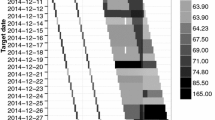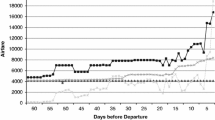Abstract
This research uses data on distribution channels of hotels gathered through a yearly survey addressed to Swiss hotels since 2006. The authors use the evolution of Online Travel Agencies (OTAs) market share as a time series which can be modelled using different growth curve methods. These various models cross-validate the forecasted final penetration rate. The study analyses the dynamics of the evolution of OTAs and determines their final penetration rate not only on an overall level, but also segmented by hotel category, location and size. Overall, a final penetration of around 35 % is predicted by our models, but they show also that the level of final penetration of OTAs depends on the typology of the hotel. The paper sheds some light on the statistical difficulties in forecasting with a limited set of data and gives insights into the future evolution of the distribution mix which is essential for the marketing and pricing strategy of hotels.
Access this chapter
Tax calculation will be finalised at checkout
Purchases are for personal use only
Similar content being viewed by others
References
Anderson, C. K. (2011). Search, OTAs, and online booking: An expanded analysis of the billboard effect. Cornell Hospitality Report, 11(8), 14.
Bass, F. M. (1969). A new product growth model for consumer durables. Management Science, 15(5), 215–227.
Bass, F. M., Jain, D., & Khishnan, T. (2000). Modeling the marketing-mix influence in new-product diffusion. In V. Mahajan, E. Muller, & Y. Wind (Eds.), New-product diffusion models. Boston, MA: Kluwer Academic.
Bemmaor, A. C., & Lee, J. (2002). The impact of heterogeneity and ill-conditioning on diffusion model parameter estimates. Marketing Science, 21(2), 209–220.
Buhalis, D. (1999). Information Technology for small and medium-sized tourism enterprises: Adaptation and benefits. Journal of Information Technology & Tourism, 2(2), 79–95. Retrieved from http://www.sciencedirect.com/science/article/pii/S0261517799000953.
Buhalis, D. (2003). ETourism: Information technology for strategic tourism management. Harlow: Financial Times Prentice Hall.
Caroll, B., & Siguaw, J. (2003). The evolution of electronic distribution. Cornell Hotel and Restaurant Administration Quarterly, 44(4), 38–50.
Egger, R., & Buhalis, D. (2008). ETourism case studies: Management and marketing issues. Oxford: Butterworth-Heinemann.
Euromonitor. (2014). The new online travel consumer – Featuring euromonitor international and the ETOA. Retrieved from http://aggregator.us/THE-NEW-ONLINE-TRAVEL-CONSUMER-ETOA-European.html
Fisher, J. C., & Pry, R. H. (1971). A simple substitution model of technological change. Technological Forecasting and Social Change, 3, 75–88. doi:10.1016/S0040-1625(71)80005-7.
Ford, R. C., Wang, Y., & Vestal, A. (2012). Power asymmetries in tourism distribution networks. Annals of Tourism Research, 39(2), 755–779. doi:10.1016/j.annals.2011.10.001.
Gazzoli, G., Kim, W. G., & Palakurthi, R. (2008). Online distribution strategies and competition: Are the global hotel companies getting it right? International Journal of Contemporary Hospitality Management, 20(4), 375–387. doi:10.1108/09596110810873499.
Harvey, A. C. (1990). Forecasting, structural time series models and the Kalman filter. Cambridge: Cambridge university press.
Irvine, W., & Anderson, A. R. (2008). ICT (Information communication technology), peripherality and smaller hospitality business in Scotland. International Journal of Entrepreneurial Behaviour & Research, 14(4), 200–218.
Kang, B., Brewer, K. P., & Baloglu, S. (2007). Profitability and survivability of hotel distribution channels. Journal of Travel & Tourism Marketing, 22(1), 37–50. doi:10.1300/J073v22n01_03.
Kracht, J., & Wang, Y. (2010). Examining the tourism distribution channel: Evolution and transformation. International Journal of Contemporary Hospitality Management, 22(4–5), 736–757.
Ku, E. C., & Fan, Y. W. (2009). The decision making in selecting online travel agencies: An application of analytic hierarchy process. Journal of Travel and Tourism Marketing, 26(5–6), 482–493.
Law, R., & Jogaratnam, G. (2005). A study of hotel information technology applications. International Journal of Contemporary Hospitality Management, 17(2), 170–180.
Mahajan, V., Muller, E., & Srivastava, R. (1990, February). Determination of adopter categories by using innovation diffusion models. Journal of Marketing Research, XXVII, 37–50.
Mansfield, E. (1961). Technical change and the rate of imitation. Econometrica, 29(4), 741–766.
Meade, N., & Islam, T. (2006). Modelling and forecasting the diffusion of innovation-A 25-year review. International Journal of Forecasting, 22(3), 519–545.
Morosan, C., & Jeong, M. (2008). Users’ perceptions of two types of hotel reservation Web sites. International Journal of Hospitality Management, 27(2), 284–292.
O’Connor, P. (2001). Room rates on the internet – Is the web really cheaper? Journal of Services Research, 1(1), 57–72.
O’Connor, P., & Frew, A. J. (2002). The future of hotel electronic distribution: Expert and industry perspectives. Cornell Hotel and Restaurant Administration Quarterly, 43(3), 33–45. http://doi.org/10.1016/S0010-8804(02)80016-7.
Perruchoud-Massy, M.-F., Scaglione, M., Schegg, R., & Murphy, J. (2005). Adoption of innovation by Swiss hotels: Exploring internet strategies and dynamics. In P. Keller & T. Bieger (Eds.), Innovation in tourism: Creating customer value/AIEST, 55th congress 2005, Brainerd, USA (Vol. 67, pp. 171–185). St. Gallen: International Association of Scientific Experts in Tourism.
PhoCusWright. (2014). Europe’s meta game: Update on evolution of travel search. Retrieved from http://www.phocuswright.com/Travel-Research/Social-Search/Europe-s-Meta-Game-Update-on-Evolution-of-Travel-Search
Rogers, E. M. (1962). Diffusion of innovations (1st ed.). New York: The Free Press.
Rossini, A. (2015). OTA sector between increasing consolidation and the possible rise of new key players. Retrieved from http://blog.euromonitor.com/2015/06/ota-sector-between-increasing-consolidation-and-the-possible-rise-of-new-key-players.html
Runfola, A., Rosati, M., & Guercini, S. (2013). New business models in online hotel distribution: Emerging private sales versus leading IDS. Service Business, 7(2), 183–205. doi:10.1007/s11628-012-0150-1.
SAS Institute Inc. (2011). SAS/STAT® 9.22 user’s guide. Cary: SAS Institute Inc.
Scaglione, M., & Schegg, R. (2015). The impact of attribute preferences on adoption timing of hotel distribution channels: Are OTAs winning the customer race? In I. Tussyadiah & A. Inversini (Eds.), Information and communication technologies in tourism 2015 (pp. 681–693). Cham: Springer.
Scaglione, M., Schegg, R., Steiner, T., & Murphy, J. (2004a). The diffusion of domain names by small and medium-sized Swiss hotels. In P. Keller & T. Bieger (Eds.), The future of small and medium sized enterprises in tourism 54th AIEST congress (Vol. 46, pp. 259–271). St. Gallen: International Association of Scientific Experts in Tourism.
Scaglione, M., Schegg, R., Steiner, T., & Murphy, J. (2004b). Internet adoption by Swiss hotels: The dynamics of domain name registration. In A. J. Frew (Ed.), Proceedings of the 11th international conference on information technologies in tourism, Cairo, Egypt (pp. 479–488). New York: Springer.
Schaal, D. (2015). And then the earth shook: Google enters travel booking. Retrieved from http://skift.com/2015/07/13/and-then-the-earth-shook-google-enters-travel-booking/
Schegg, R. (2014). European hotel distribution study: The rise of online intermediaries. Special Focus Switzerland. Retrieved from http://etourism-monitor.ch/node/129
Schegg, R. (2015). Swiss hotel distribution study: Are OTAs winning the customer race? Retrieved from http://etourism-monitor.ch/node/135
Schegg, R. & Fux, M. (2010). Die Bedeutung des Online-Vertriebs in der Schweizer Hotellerie. Jahrbuch der Schweizer Hotellerie, 101–104.
Schegg, R., & Scaglione, M. (2013). Substitution effects across hotel distribution channels. In Z. Xiang & I. Tussyadiah (Eds.), Information and communication technologies in tourism 2014 (pp. 801–812). Cham: Springer.
Schegg, R., Stangl, B., Fux, M., & Inversini, A. (2013). Distribution channels and management in the Swiss hotel sector. In L. Cantoni & Z. Xiang (Eds.), Information and communication technologies in tourism 2013 (pp. 554–565). Berlin: Springer.
Schegg, R., Steiner, T., Frey, S., & Murphy, J. (2002). Benchmarks of Web site design and marketing by Swiss hotels. Information Technology & Tourism, 5(2), 73–89.
Srinivasan, V., & Mason, C. H. (1986). Technical note – Nonlinear least squares estimation of new product diffusion models. Marketing Science, 5(2), 169–178. doi:10.1287/mksc.5.2.169.
Thompson, G. (2005). Hotel room rates across booking channels. Cornell Hotel and Restaurent Administration Quarterly, 46(2), 106–107.
Toh, R. S., Raven, P., & DeKay, F. (2011). Selling rooms: Hotels vs. third-party websites. Cornell Hospitality Quarterly, 52(2), 181–189.
Van den Bulte, C., & Lilien, G. L. (1997). Bias and systematic change in the parameter estimates of macro-level diffusion models. Marketing Science, 16(4), 338–353. doi:10.1287/mksc.16.4.338.
Varini, K., Scaglione, M., & Schegg, R. (2011). Distribution channel and efficiency: An analytic hierarchy process approach. In R. Law, M. Fuchs, & F. Ricci (Eds.), Information and communication technologies in tourism 2011: Proceedings of the international conference in Innsbruck, Austria, January 26–28, 2011. Wien/New York: Springer.
Werthner, H., & Klein, S. (1999). Information technology and tourism – A challenging relationship (1st ed.). Vienna: Springer.
Young, P., & Ord, K. (1985). The use of discounted least squares in technological forecasting. Technological Forecasting and Social Change, 28(3), 263–274. doi:10.1016/0040-1625(85)90048-4.
Acknowledgements
A first draft of this paper was presented at the 2013 conference of the International Association of Scientific Experts in Tourism (AIEST) (Izmir-Turkey, 25–29.8.2013). The authors thank the participants for the comments and suggestions.
Author information
Authors and Affiliations
Corresponding author
Editor information
Editors and Affiliations
Rights and permissions
Copyright information
© 2016 Springer International Publishing Switzerland
About this paper
Cite this paper
Scaglione, M., Schegg, R. (2016). Forecasting the Final Penetration Rate of Online Travel Agencies in Different Hotel Segments. In: Inversini, A., Schegg, R. (eds) Information and Communication Technologies in Tourism 2016. Springer, Cham. https://doi.org/10.1007/978-3-319-28231-2_51
Download citation
DOI: https://doi.org/10.1007/978-3-319-28231-2_51
Published:
Publisher Name: Springer, Cham
Print ISBN: 978-3-319-28230-5
Online ISBN: 978-3-319-28231-2
eBook Packages: Business and ManagementBusiness and Management (R0)




